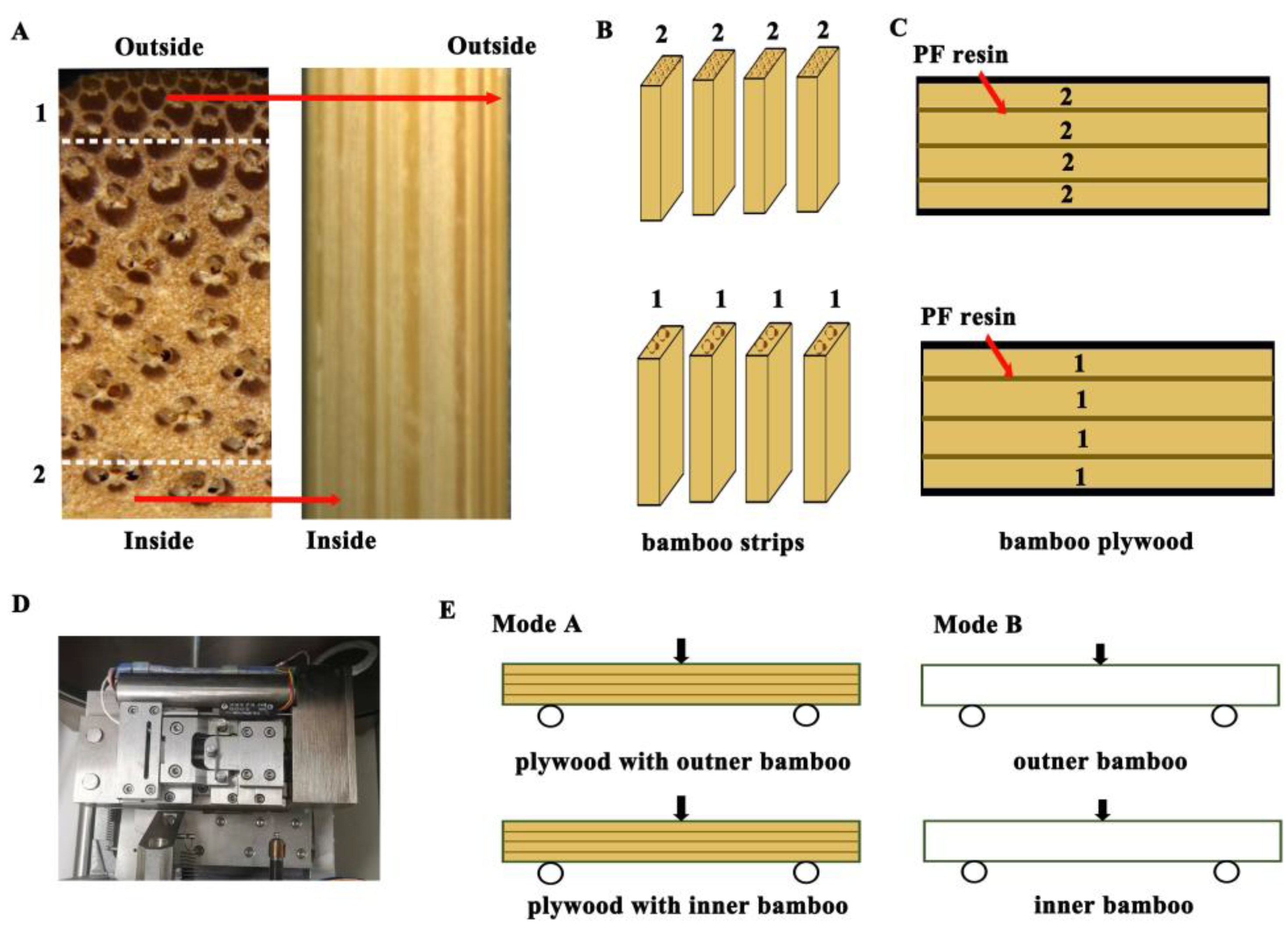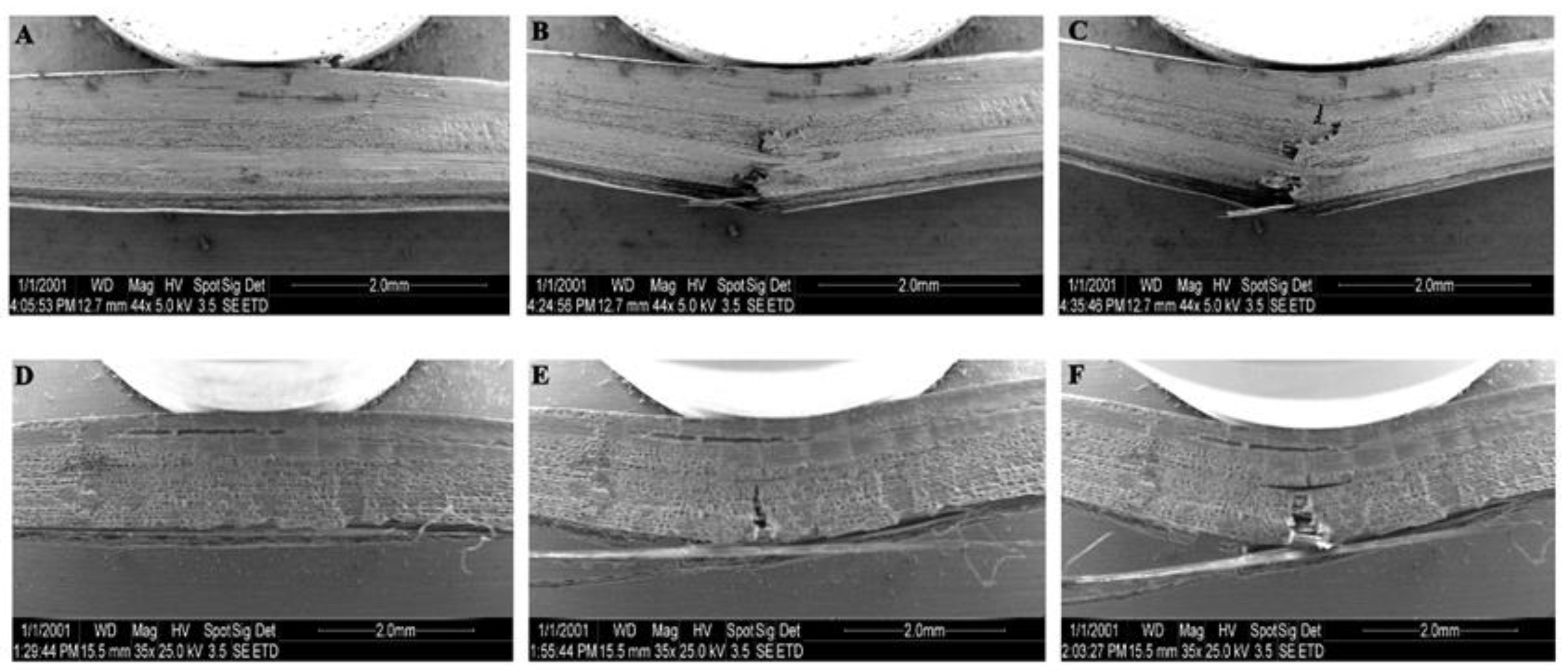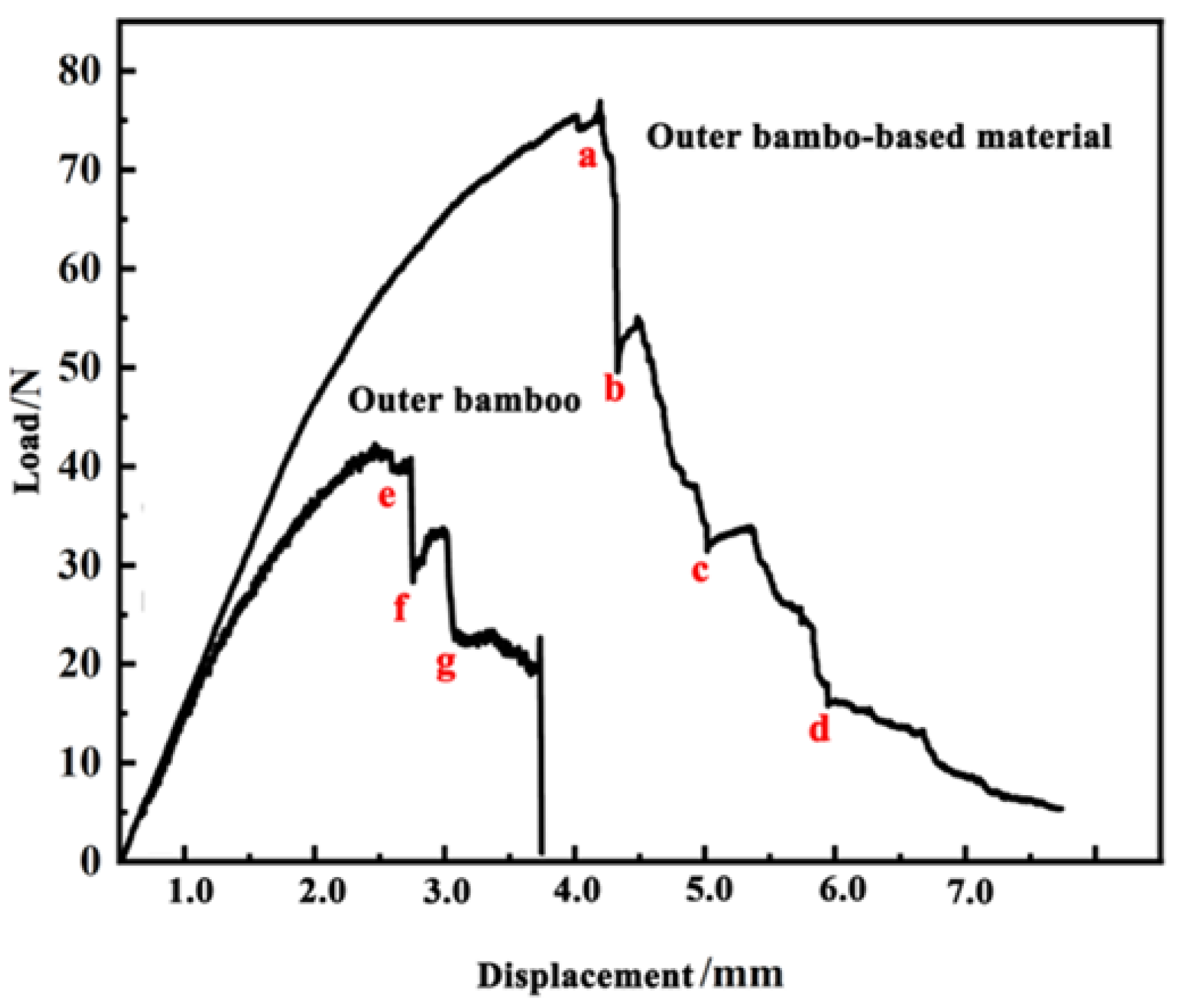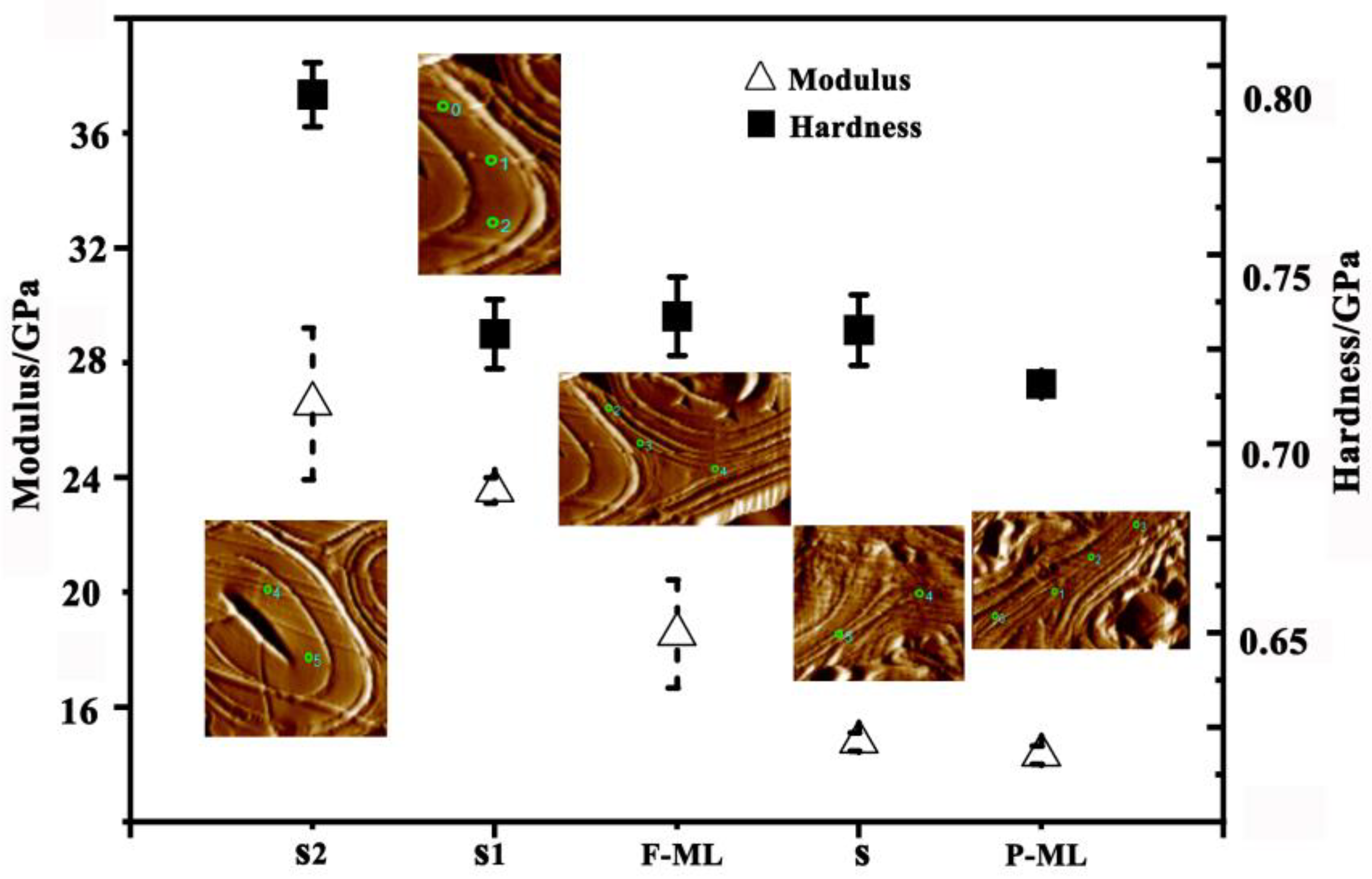In Situ Detection of the Flexural Fracture Behaviors of Inner and Outer Bamboo-Based Composites
Abstract
:1. Introduction
2. Materials and Methods
2.1. Samples Preparation
2.2. In Situ Mechanical Tests
2.3. Morphology Characterization
2.4. Nanoindentation and Dynamic Modulus Analysis
3. Results
3.1. The Fracture Behavior of Inner Bamboo-Based Composites
3.2. Fracture Behavior of Outer Bamboo-Based Composites
3.3. Micro-Mechanical Properties of Cell Walls in Bamboo-Based Composites
4. Discussion
5. Conclusions
Author Contributions
Funding
Data Availability Statement
Conflicts of Interest
References
- Lugt, V.; Dobbelsteen, V.D. An environmental, economic and practical assessment of bamboo as a building material for supporting structures. Constr. Build. Mater. 2006, 20, 648–656. [Google Scholar] [CrossRef]
- Li, Y.; Xu, b.; Zhang, Q. Present situation and the countermeasure analysis of bamboo timber processing industry in China. J. For. Eng. 2016, 1, 2–7. (In Chinese) [Google Scholar]
- Sharma, B.; Gatoo, A.; Bock, M. Engineered bamboo for structural applications. Constr. Build. Mater. 2015, 81, 66–73. [Google Scholar] [CrossRef]
- Wu, B.; Gatoo, A.; Bock, M. Engineered bamboo for structural applications. J. Nanjing For. Univ. (Nat. Sci. Ed.). 2014, 38, 115–120. (In Chinese) [Google Scholar]
- Qi, J.; Xie, J.; Huang, X.; Yu, W.; Chen, S. Influence of characteristic inhomogeneity of bamboo culm on mechanical properties of bamboo plywood: Effect of culm height. J. Wood. Sci. 2014, 60, 396–402. [Google Scholar] [CrossRef]
- Zhan, T.; Sun, F.; Chao, L. Moisture diffusion properties of graded hierarchical structure of bamboo: Longitudinal and radial variations. Constr. Build. Mater. 2020, 259, 119641. [Google Scholar] [CrossRef]
- Nogata, F.; Takahashi, H. Intelligent functionally graded material: Bamboo. Composites. 1995, 5, 743–751. [Google Scholar] [CrossRef]
- Nkeuwa, W.; Zhang, J.; Semple, K.; Chen, M.; Xia, Y.; Dai, C. Bamboo-based composites: A review on fundamentals and processes of bamboo bonding. Composites 2022, 235, 109776. [Google Scholar] [CrossRef]
- Dixon, P.G.; Gibson, L.J.; Bock, M. The structure and mechanics of moso bamboo material. Sci. Rep. 2014, 11, 20140321. [Google Scholar] [CrossRef]
- Wang, X.; Ren, H.; Zhang, B.; Fei, B.; Burgert, I. Cell wall structure and formation of maturing fibres of moso bamboo (Phyllostachys pubescens) increase buckling resistance. J. R. Soc. Interface 2012, 9, 988–996. [Google Scholar] [CrossRef] [Green Version]
- Lian, C.; Liu, R.; Zhang, S.; Yuan, J.; Luo, J.; Yang, F.; Fei, B. Ultrastructure of parenchyma cell wall in bamboo (Phyllostachys edulis) culms. Cellulose 2020, 27, 7321–7329. [Google Scholar] [CrossRef]
- Parameswaran, N.; Liese, W. On the fine structure of bamboo fibres. Wood Sci. Technol. 1976, 10, 231–246. [Google Scholar] [CrossRef]
- Shao, Z.; Fang, C.; Huang, S. Tensile properties of moso bamboo (Phyllostachys pubescens) and its components with respect to its fiber-reinforced composite structure. Wood Sci. Technol. 2010, 44, 655–666. [Google Scholar] [CrossRef]
- Habibi, M.; Lu, Y. Cracks propagation in bamboo’s hierarchical cellular structure. Sci. Rep. 2014, 4, 5598. [Google Scholar] [CrossRef] [PubMed] [Green Version]
- Liu, H.; Wang, X.; Zhang, X.; Sun, Z.; Jiang, Z. In situ detection of the fracture behaviour of moso bamboo (phyllostachys pubescens) by scanning electron microscopy. Holzforschung 2016, 70, 1183–1190. [Google Scholar] [CrossRef]
- Wang, F.; Shao, Z.; Bock, M. Study on the variation law of bamboo fibers’ tensile properties and the organization structure on the radial direction of bamboo stem. Ind. Crops Prod. 2020, 152, 112521. [Google Scholar] [CrossRef]
- Wang, D.; Lin, L.; Fu, F. Fracture mechanisms of moso bamboo (Phyllostachys pubescens) under longitudinal tensile loading. Ind. Crops Prod. 2020, 153, 112574. [Google Scholar] [CrossRef]
- Obataya, E.; Kitin, P.; Yamauchi, H. Bending characteristics of bamboo (Phyllostachys pubescens) with respect to its fiber–foam composite structure. Wood Sci. Technol. 2007, 41, 385–400. [Google Scholar] [CrossRef]
- Chen, M.; Ye, L.; Wang, G.; Fang, C.; Dai, C.; Fei, B. Fracture modes of bamboo fiber bundles in three-point bending. Cellulose 2019, 26, 8101–8108. [Google Scholar] [CrossRef]
- Hao, X.; Tian, X.; Li, S.; Yang, C.; Yu, Y.; Yu, W. The separation mechanism of bamboo bundles at the cellular level. Forests 2022, 13, 1897. [Google Scholar] [CrossRef]
- Yu, W.; Yu, Y. Development and prospect of wood and bamboo scrimber industry in China. China Wood Ind. 2013, 27, 5–8. (In Chinese) [Google Scholar]
- Zhang, Y.; Huang, Y.; Zhang, Y.; Yu, Y.; Yu, W. Scrimber board (sb) manufacturing by a new method and characterization of sb’s mechanical properties and dimensional stability. Holzforschung 2018, 72, 283–289. [Google Scholar] [CrossRef]
- Wei, J.; Rao, F.; Zhang, Y.; Li, C.; Yu, W. Effect of veneer crushing process on physical and mechanical properties of scrimbers made of pinus radiata and populus tomentosa. China Wood Ind. 2019, 33, 55–58. (In Chinese) [Google Scholar]
- Yu, Y. Manufacturing technology and mechanism of high performance bamboo-based fiber composites. Ph.D. Thesis, Chinese Academy of Forestry, Beijing, China, 2014. (In Chinese). [Google Scholar]
- Bao, M.; Huang, X.; Zhang, Y.; Yu, W.; Yu, Y. Effect of density on the hygroscopicity and surface characteristics of hybrid poplar compreg. Wood Sci. Technol. 2016, 62, 441–451. [Google Scholar] [CrossRef] [Green Version]
- Li, J.; Wu, Z.; He, S.; Huang, C.; Chen, Y. Effect of bundle diameter on water absorption properties of bamboo scrimber. J. Zhejiang For. Sci. Technol. 2016, 36, 67–70. (In Chinese) [Google Scholar]
- Li, Q.; Wang, K.; Yang, W.; Hua, X.; Weng, F.; He, Q. Research on technology of remaking bamboo glued board. J. Bamboo. Re. 2003, 22, 56–60. (In Chinese) [Google Scholar]
- Fu, Y.; Fang, H.; Dai, F. Study on the properties of the recombinant bamboo by finite element method. Composites 2017, 115, 151–159. [Google Scholar] [CrossRef]
- Kumar, A.; Vlach, T.; Laiblova, L. Engineered bamboo scrimber: Influence of density on the mechanical and water absorption properties. Constr. Build. Mater. 2016, 127, 815–827. [Google Scholar] [CrossRef]
- Li, Z.; Chen, C.; Mi, R.; Gan, W.; Dai, J.; Jiao, M.; Xie, H.; Yao, Y.; Xiao, S.; Hu, L. A Strong, Tough, and Scalable Structural Material from Fast growing Bamboo. Adv. Mater. 2020, 32, 1906308. [Google Scholar] [CrossRef]
- Yu, Y.; Liu, R.; Huang, Y.; Meng, F.; Yu, W. Preparation, physical, mechanical, and interfacial morphological properties of engineered bamboo scrimber. Constr. Build. Mater. 2017, 157, 1032–1039. [Google Scholar] [CrossRef]
- Yu, Y.; Huang, X.; Yu, W. A novel process to improve yield and mechanical performance of bamboo fiber reinforced composite via mechanical treatments. Composites 2014, 56, 48–53. [Google Scholar] [CrossRef]
- Meng, F. Study on the bonding interface and mechanism of bamboo-based fiber composites. Ph.D. Thesis, Beijing Forestry University, Beijing, China, 2017. (In Chinese). [Google Scholar]
- Shams, M.; Kagemori, N.; Yano, H. Compressive deformation of wood impregnated with low molecular weight phenol formaldehyde (PF) resin Ⅳ: Species dependency. J. Wood Sci. 2006, 52, 179–183. [Google Scholar] [CrossRef]
- Wang, X.; Luo, X.; Ren, H. Bending failure mechanism of bamboo scrimber. Constr. Build. Mater. 2022, 4, 326. [Google Scholar] [CrossRef]








Disclaimer/Publisher’s Note: The statements, opinions and data contained in all publications are solely those of the individual author(s) and contributor(s) and not of MDPI and/or the editor(s). MDPI and/or the editor(s) disclaim responsibility for any injury to people or property resulting from any ideas, methods, instructions or products referred to in the content. |
© 2023 by the authors. Licensee MDPI, Basel, Switzerland. This article is an open access article distributed under the terms and conditions of the Creative Commons Attribution (CC BY) license (https://creativecommons.org/licenses/by/4.0/).
Share and Cite
Hao, X.; Yu, Y.; Yang, C.; Yu, W. In Situ Detection of the Flexural Fracture Behaviors of Inner and Outer Bamboo-Based Composites. Forests 2023, 14, 515. https://doi.org/10.3390/f14030515
Hao X, Yu Y, Yang C, Yu W. In Situ Detection of the Flexural Fracture Behaviors of Inner and Outer Bamboo-Based Composites. Forests. 2023; 14(3):515. https://doi.org/10.3390/f14030515
Chicago/Turabian StyleHao, Xiu, Yanglun Yu, Chunmei Yang, and Wenji Yu. 2023. "In Situ Detection of the Flexural Fracture Behaviors of Inner and Outer Bamboo-Based Composites" Forests 14, no. 3: 515. https://doi.org/10.3390/f14030515








